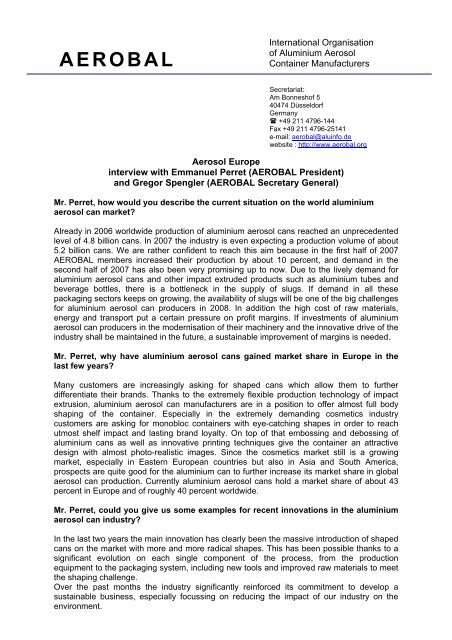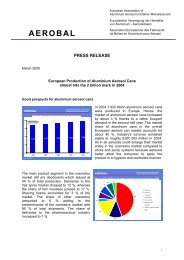Interview with Emmanuel Perret (AEROBAL President) and Gregor
Interview with Emmanuel Perret (AEROBAL President) and Gregor
Interview with Emmanuel Perret (AEROBAL President) and Gregor
You also want an ePaper? Increase the reach of your titles
YUMPU automatically turns print PDFs into web optimized ePapers that Google loves.
<strong>AEROBAL</strong><br />
International Organisation<br />
of Aluminium Aerosol<br />
Container Manufacturers<br />
Secretariat:<br />
Am Bonneshof 5<br />
40474 Düsseldorf<br />
Germany<br />
� +49 211 4796-144<br />
Fax +49 211 4796-25141<br />
e-mail: aerobal@aluinfo.de<br />
website : http://www.aerobal.org<br />
Aerosol Europe<br />
interview <strong>with</strong> <strong>Emmanuel</strong> <strong>Perret</strong> (<strong>AEROBAL</strong> <strong>President</strong>)<br />
<strong>and</strong> <strong>Gregor</strong> Spengler (<strong>AEROBAL</strong> Secretary General)<br />
Mr. <strong>Perret</strong>, how would you describe the current situation on the world aluminium<br />
aerosol can market?<br />
Already in 2006 worldwide production of aluminium aerosol cans reached an unprecedented<br />
level of 4.8 billion cans. In 2007 the industry is even expecting a production volume of about<br />
5.2 billion cans. We are rather confident to reach this aim because in the first half of 2007<br />
<strong>AEROBAL</strong> members increased their production by about 10 percent, <strong>and</strong> dem<strong>and</strong> in the<br />
second half of 2007 has also been very promising up to now. Due to the lively dem<strong>and</strong> for<br />
aluminium aerosol cans <strong>and</strong> other impact extruded products such as aluminium tubes <strong>and</strong><br />
beverage bottles, there is a bottleneck in the supply of slugs. If dem<strong>and</strong> in all these<br />
packaging sectors keeps on growing, the availability of slugs will be one of the big challenges<br />
for aluminium aerosol can producers in 2008. In addition the high cost of raw materials,<br />
energy <strong>and</strong> transport put a certain pressure on profit margins. If investments of aluminium<br />
aerosol can producers in the modernisation of their machinery <strong>and</strong> the innovative drive of the<br />
industry shall be maintained in the future, a sustainable improvement of margins is needed.<br />
Mr. <strong>Perret</strong>, why have aluminium aerosol cans gained market share in Europe in the<br />
last few years?<br />
Many customers are increasingly asking for shaped cans which allow them to further<br />
differentiate their br<strong>and</strong>s. Thanks to the extremely flexible production technology of impact<br />
extrusion, aluminium aerosol can manufacturers are in a position to offer almost full body<br />
shaping of the container. Especially in the extremely dem<strong>and</strong>ing cosmetics industry<br />
customers are asking for monobloc containers <strong>with</strong> eye-catching shapes in order to reach<br />
utmost shelf impact <strong>and</strong> lasting br<strong>and</strong> loyalty. On top of that embossing <strong>and</strong> debossing of<br />
aluminium cans as well as innovative printing techniques give the container an attractive<br />
design <strong>with</strong> almost photo-realistic images. Since the cosmetics market still is a growing<br />
market, especially in Eastern European countries but also in Asia <strong>and</strong> South America,<br />
prospects are quite good for the aluminium can to further increase its market share in global<br />
aerosol can production. Currently aluminium aerosol cans hold a market share of about 43<br />
percent in Europe <strong>and</strong> of roughly 40 percent worldwide.<br />
Mr. <strong>Perret</strong>, could you give us some examples for recent innovations in the aluminium<br />
aerosol can industry?<br />
In the last two years the main innovation has clearly been the massive introduction of shaped<br />
cans on the market <strong>with</strong> more <strong>and</strong> more radical shapes. This has been possible thanks to a<br />
significant evolution on each single component of the process, from the production<br />
equipment to the packaging system, including new tools <strong>and</strong> improved raw materials to meet<br />
the shaping challenge.<br />
Over the past months the industry significantly reinforced its commitment to develop a<br />
sustainable business, especially focussing on reducing the impact of our industry on the<br />
environment.
Although the industry is working at reducing this impact since many years <strong>with</strong> major actions<br />
such as implementing solvent-free product cleaning processes or continous downgauging of<br />
the cans, we are now moving further <strong>with</strong> the implementation of coatings using far less<br />
solvents. Examples are high solid content or water-based coatings <strong>and</strong> even solvent-free<br />
systems like powder coatings which have been recently introduced on the market for some<br />
specialties. These are very promising technologies that will allow the industry to produce<br />
cans <strong>with</strong> almost no VOC emissions throughout the process. Moreover, these implemented<br />
technologies will also allow significant energy savings <strong>and</strong> thus a reduction of CO2<br />
emissions.<br />
Significant developments are also being made in the printing technology to come closer <strong>and</strong><br />
closer to photographic printing quality allowing to reinforce our customers’ br<strong>and</strong> image. The<br />
laser engraved plates technology introduced recently on the market is opening new<br />
possibilities for artwork designers to get an even more attractive product.<br />
Mr. Spengler, what is the aluminium aerosol can industry doing to prepare for the<br />
discussions <strong>with</strong> customers about the sustainability of the aluminium aerosol can<br />
industry?<br />
European governments, retailers <strong>and</strong> big customers of aluminium aerosol can producers are<br />
increasingly discussing ecotaxes on packaging, carbon footprint labelling <strong>and</strong> life cycle<br />
analyses of products. Aluminium aerosol can producers are currently preparing for these<br />
discussions <strong>with</strong> hard facts. For this purpose <strong>AEROBAL</strong> has chosen the “cradle-to-grave” life<br />
cycle analysis approach. This approach is trying to determine the entire impact of the product<br />
on the environment, whereas mono-causal approaches such as CO2 footprint are only<br />
considering part of the impact <strong>and</strong> may completely mislead the industry.<br />
<strong>AEROBAL</strong> developed a life cycle analysis questionnaire for aluminium aerosol cans which<br />
reflects the complete production process. Together <strong>with</strong> a similar questionnaire for the slug<br />
production <strong>and</strong> existing tools for primary aluminium production, casting <strong>and</strong> recycling,<br />
<strong>AEROBAL</strong> will be in a position to mirror the whole life cycle of aluminium aerosol cans from<br />
primary aluminium production up to recycling.<br />
Mr. Spengler, how are <strong>AEROBAL</strong> members tackling the challenges arising from the<br />
coming REACH Regulation?<br />
The new REACH Regulation (Registration, Evaluation, Authorisation <strong>and</strong> Restriction of<br />
Chemicals) will have far-reaching consequences for many suppliers to the aluminium aerosol<br />
can industry <strong>and</strong> for the can manufacturers themselves. In this framework aluminium aerosol<br />
can producers act as downstream users. A key step for downstream users to comply <strong>with</strong><br />
REACH is to have a full overview of what substances or preparations the company uses or<br />
imports, including substances in articles that the company uses or imports. Such a substance<br />
inventory will<br />
- support companies in fulfilling their downstream user obligations<br />
- help them to get an overview of the potential implications of REACH<br />
- secure the necessary future supply of substances/preparations<br />
Also for <strong>AEROBAL</strong> members it is essential to work on such an inventory list. Coatings were<br />
identified by <strong>AEROBAL</strong> members to probably be the most crucial/critical part of this inventory<br />
list because deselection of substances in this area might be a threat to the aluminium aerosol<br />
can industry. It was decided to launch a joint <strong>AEROBAL</strong> activity in this field. In order to work<br />
on an <strong>AEROBAL</strong> inventory list on external <strong>and</strong> internal coatings all <strong>AEROBAL</strong> members who<br />
produce aerosol cans in Europe or export aerosol cans to Europe will name their coatings<br />
(internal lacquers, base coatings, printing inks, overvarnishes) including the suppliers of<br />
these coatings to the <strong>AEROBAL</strong> Secretariat. The <strong>AEROBAL</strong> Secretariat will collect all the<br />
information <strong>and</strong> produce one consolidated inventory list of all coatings used by the industry.<br />
Afterwards the coating suppliers will be contacted on the basis of the consolidated inventory
list to make sure that all relevant information on the coatings used is collected <strong>and</strong> to check<br />
whether there is any risk of deselection.<br />
Mr. <strong>Perret</strong>, what is <strong>AEROBAL</strong>'s position on the alternative to the water bath test?<br />
It is part of <strong>AEROBAL</strong>’s mission to support the development of the industry towards safer<br />
<strong>and</strong> more efficient processes.<br />
Still, <strong>AEROBAL</strong> always made clear that the cold alternative test method which is currently<br />
laid down in the UN Model Regilations on the Transport of Dangerous Goods cannot be<br />
applied to aluminium cans. The current provisions under chapter 6.2.4.2.2.2 of the Model<br />
Regulations that the test pressure shall be at least two-thirds of the design pressure of the<br />
aerosol dispenser cannot be matched by aluminium aerosol can producers. With relatively<br />
high test pressures of up to 18 bar <strong>and</strong> <strong>with</strong> shaped cans, available test devices have a<br />
detrimental effect on the can. Resulting deformations of aluminium cans – due to material<br />
properties – would lead to risks in the supply chain. This is not acceptable for aluminium<br />
aerosol can producers for product <strong>and</strong> consumer safety reasons.<br />
Nevertheless, <strong>AEROBAL</strong> is making constructive approaches challenging the industry to<br />
move towards better performances in all areas. Indeed, <strong>AEROBAL</strong> very much appreciates<br />
that meanwhile an agreement was found <strong>with</strong> FEA to install a working group under the FEA<br />
umbrella to work on the following subjects<br />
- Production of a FEA guideline on the interpretation of the current provisions for “cold”<br />
alternative test methods in the UN Model Regulations for a proper implementation by<br />
national competent authorities<br />
- Development of a “cold” alternative test method suitable for aluminium aerosol cans<br />
- Investigations to define „hot“ alternatives<br />
A first meeting of the task force is planned before the end of this year. <strong>AEROBAL</strong> members<br />
will actively contribute to this work.<br />
Mr. Spengler, how do you see the future of aluminium aerosol cans?<br />
The future of aluminium aerosol cans will definitely be bright.<br />
Currently dem<strong>and</strong> in Europe, North America <strong>and</strong> parts of South America (for example<br />
Argentina) is very strong. And there are no signals on the horizon that this situation is going<br />
to change in the near future. On top of that rapidly growing markets such as Russia, Asia <strong>and</strong><br />
some other South American countries are going to catch up. Today their per capita<br />
consumption of aerosols is in some cases far below one can per person per year, whereas<br />
per capita consumption in Europe <strong>and</strong> the US amounts to about 10 cans per person per<br />
year. With rising per capita income <strong>and</strong> a subsequently increasing relevance of the<br />
cosmetics market in these growing economic areas also dem<strong>and</strong> for aluminium aerosol cans<br />
is going to rise. In this context please bear in mind that about 80 percent of aluminium<br />
aerosols are sold to the cosmetics market. So there is a huge growth potential in these<br />
markets.<br />
I am convinced that aluminium aerosols will globally become a packaging of choice in the<br />
cosmetics industry because they are attractive, unbreakable, light, easy to use, recyclable<br />
<strong>and</strong> allow a hygienic <strong>and</strong> well-dosed application of the product. Thus they offer convincing<br />
advantages for br<strong>and</strong> owners <strong>and</strong> consumers alike. These convincing characteristics will<br />
pave the way for a promising future of the aluminium aerosol can industry.




